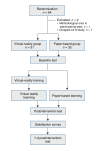Immersive and interactive virtual reality to improve learning and retention of neuroanatomy in medical students: a randomized controlled study
- PMID: 29510979
- PMCID: PMC5878950
- DOI: 10.9778/cmajo.20170110
Immersive and interactive virtual reality to improve learning and retention of neuroanatomy in medical students: a randomized controlled study
Abstract
Background: Spatial 3-dimensional understanding of the brain is essential to learning neuroanatomy, and 3-dimensional learning techniques have been proposed as tools to enhance neuroanatomy training. The aim of this study was to examine the impact of immersive virtual-reality neuroanatomy training and compare it to traditional paper-based methods.
Methods: In this randomized controlled study, participants consisted of first- or second-year medical students from the University of Saskatchewan recruited via email and posters displayed throughout the medical school. Participants were randomly assigned to the virtual-reality group or the paper-based group and studied the spatial relations between neural structures for 12 minutes after performing a neuroanatomy baseline test, with both test and control questions. A postintervention test was administered immediately after the study period and 5-9 days later. Satisfaction measures were obtained.
Results: Of the 66 participants randomly assigned to the study groups, 64 were included in the final analysis, 31 in the virtual-reality group and 33 in the paper-based group. The 2 groups performed comparably on the baseline questions and showed significant performance improvement on the test questions following study. There were no significant differences between groups for the control questions, the postintervention test questions or the 7-day postintervention test questions. Satisfaction survey results indicated that neurophobia was decreased.
Interpretation: Results from this study provide evidence that training in neuroanatomy in an immersive and interactive virtual-reality environment may be an effective neuroanatomy learning tool that warrants further study. They also suggest that integration of virtual-reality into neuroanatomy training may improve knowledge retention, increase study motivation and decrease neurophobia.
Copyright 2018, Joule Inc. or its licensors.
Conflict of interest statement
Competing interests: None declared.
Figures



References
-
- Hazelton L. Changing concepts of neuroanatomy teaching in medical education. Teach Learn Med. 2011;23:359–64. - PubMed
-
- Allen LK, Bhattacharyya S, Wilson TD. Development of an interactive anatomical three‐dimensional eye model. Anat Sci Educ. 2015;8:275–82. - PubMed
-
- Chang BS, Molnar Z. Practical neuroanatomy teaching in the 21st century. Ann Neurol. 2015;77:911–6. - PubMed
-
- Drake RL, McBride JM, Lachman N, et al. Medical education in the anatomical sciences: The winds of change continue to blow. Anat Sci Educ. 2009;2:253–9. - PubMed
-
- McLachlan JC, Bligh J, Bradley P, et al. Teaching anatomy without cadavers. Med Educ. 2004;38:418–24. - PubMed
LinkOut - more resources
Full Text Sources
Other Literature Sources
